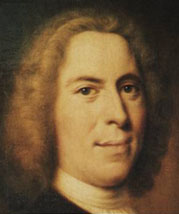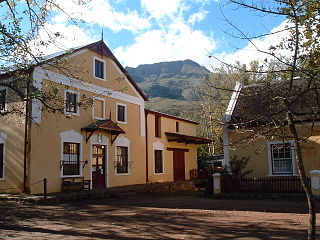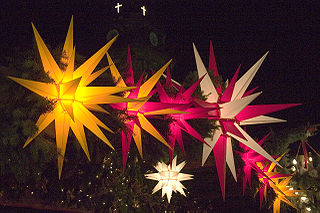
A nonprofit organization (NPO), also known as a nonbusiness entity or nonprofit institution, and often referred to simply as a nonprofit, is a legal entity organized and operated for a collective, public or social benefit, as opposed to an entity that operates as a business aiming to generate a profit for its owners. A nonprofit is subject to the non-distribution constraint: any revenues that exceed expenses must be committed to the organization's purpose, not taken by private parties. An array of organizations are nonprofit, including some political organizations, schools, business associations, churches, social clubs, and consumer cooperatives. Nonprofit entities may seek approval from governments to be tax-exempt, and some may also qualify to receive tax-deductible contributions, but an entity may incorporate as a nonprofit entity without having tax-exempt status.

Nikolaus Ludwig, Reichsgraf von Zinzendorf und Pottendorf was a German religious and social reformer, bishop of the Moravian Church, founder of the Herrnhuter Brüdergemeine, Christian mission pioneer and a major figure of 18th-century Protestantism.

Herrnhut is an Upper Lusatian town in the Görlitz district in Saxony, Germany, known for the community of the Moravian Church established by Nicolas Ludwig, Count von Zinzendorf, in 1722.

The Moravian Church, or the Moravian Brethren, formally the Unitas Fratrum, is one of the oldest Protestant denominations in Christianity, dating back to the Bohemian Reformation of the 15th century and the Unity of the Brethren founded in the Kingdom of Bohemia, sixty years before Luther's Reformation.

God's Acre is a churchyard, specifically the burial ground. The word comes from the German word Gottesacker, an ancient designation for a burial ground. The use of "Acre" is related to, but not derived from the unit of measurement and can be of any size. In the early 17th century the term was used as a translation of the German, but by the end of the century, it was accepted as an English term.

Church Women United (CWU) is a national ecumenical Christian women's movement representing Protestant, Roman Catholic, Orthodox and other Christian women. Founded in 1941, as the United Council of Church Women, this organization has more than 1,200 local and state units in the United States and Puerto Rico. CWU's members represent 26 supporting denominations and organizations. Offices are located in New York City, Washington DC and at the United Nations.

Genadendal is a town in the Western Cape province of South Africa, built on the site of the oldest mission station in the country. It was originally known as Baviaanskloof, but was renamed Genadendal in 1806. Genadendal was the place of the first Teachers' Training College in South Africa, founded in 1838.

The General Conference, in several Methodist denominations, is the top legislative body for all matters within the denomination.

A Moravian star is an illuminated decoration used during the Christian liturgical seasons of Advent, Christmas, and Epiphany representing the Star of Bethlehem pointing towards the infant Jesus. The Moravian Church teaches:
...the star reminds us of God, who caused the light to shine out of darkness and of the light which is the life of humanity. It reminds us of the promise of Abraham that his descendants would be more numerous than the stars; we are reminded of the star that pointed to the “great and heavenly light from Bethlehem’s manger shining bright.” The Light shines in the darkness, and the darkness has not overcome it. This is the message of the Advent star, which also points to Jesus, who said, “I am the bright and Morning Star.” It is the star of promise, the star of fulfillment, and the star of hope.

The Moravian musical tradition in United States began with the earliest Moravian settlers in the first half of the 18th century.
These Moravians were members of a well-established church – officially called Unitas Fratrum or Unity of Brethren – that by [the mid-18th century] had already seen almost three centuries of rich experience of religious life. They were spiritual descendants of the Czech priest Jan Hus, who for his attempts at reform was martyred in 1415. Forty-two years later in 1457, some of his followers founded a church body consecrated to following Christ in simplicity and dedicated living.
This newly constituted church developed a rich and orderly ecclesiastical life in the 15th and 16th centuries, but in the Thirty Years War of 1618-48 it was virtually wiped out. In the 1720s a few exiles of this religious heritage, along with various other seekers after truth, found refuge on an estate of a Saxon nobleman named Nicholaus Ludwig von Zinzendorf. There in their village of Herrnhut the ancient church experienced a rebirth culminating in a spiritual blessing on August 13, 1727, in which their former diversity of purpose was welded into one.
In a brief five years, by 1732, that first little village of the Renewed Moravian Church began sending missionaries to all corners of the world. After establishing work in England, the Moravians sent colonists to America in 1735. The initial settlement in Georgia proved unsuccessful, partly because of war between Protestant England and Catholic Spain to the south in Florida. More permanent work was established in Pennsylvania in 1741, with the town of Bethlehem as their chief center. Other settlements in Pennsylvania followed. The Moravians purchased 100,000 acres in North Carolina and settled at Bethabara in 1753 with the central town of Salem being founded in 1766.” [Villages of the Lord]

The Rama are an indigenous people living on the eastern coast of Nicaragua. Since the start of European colonization, the Rama population has declined as a result of disease, conflict, and loss of territory. In recent years, however, the Rama population has increased to around 2,000 individuals. A majority of the population lives on the island of Rama Cay, which is located in the Bluefields Lagoon. Additional small Rama communities are dispersed on the mainland from Bluefields to Greytown. The Rama are one of three main indigenous groups on Nicaragua’s Caribbean coast.

The Moravian Church in North America is part of the worldwide Moravian Church Unity. It dates from the arrival of the first Moravian missionaries to the United States in 1735, from their Herrnhut settlement in present-day Saxony, Germany. They came to minister to the scattered German immigrants, to the Native Americans and to enslaved Africans. They founded communities to serve as home bases for these missions. The missionary "messengers" were financially supported by the work of the "laborers" in these settlements. Currently, there are more than 60,000 members.
This article covers the period from the origin of the Moravian Church, as well as the related Hussite Church and Unity of the Brethren, in the early fourteenth century to the beginning of mission work in 1732. Further expanding the article, attention will also be paid to the early Moravian settlement at Bethlehem, Pennsylvania, following their first arrival in Nazareth, Pennsylvania in 1740.

The Moravian Church of the British Province is part of the worldwide Moravian Church Unity. The Moravian Church in Britain has bishops in apostolic succession.
The Jamaica Province of the Moravian Church is part of the worldwide Moravian Church Unity.

Fairfield Moravian Church and its surrounding settlement was founded in 1785 in Fairfield, Droylsden, Lancashire, England. It was founded by Benjamin La Trobe as a centre for evangelistic work for the Moravian Church in the Manchester area. Numbers 15, 28 and 30 Fairfield Square are Grade II* listed buildings.

Fulneck Moravian Church and its associated settlement were established on the Fulneck estate, Pudsey, in the West Riding of Yorkshire, England, in 1744 by Count Nicolaus Ludwig von Zinzendorf, a Moravian Bishop and Lutheran priest, following a donation of land by the evangelical Anglican clergyman, Benjamin Ingham. Fulneck is now part of the City of Leeds, West Yorkshire.
Social enterprise lending is a form of social finance which refers to the practice of offering loans and other financing vehicles below current market rates to social enterprises and other organisations pursuing social goals. This is often referred to as "patient lending," or financing with "soft" terms. Patient lending recognises that projects with social outcomes often reach profitability later than commercial projects. Softening the terms of a loan means that a social lender may offer provisions such as longer loan terms, lower interest rates and repayment "holidays" where capital and interest repayments are not due until the project is profitable. Social lenders might also offer small grants as part of an investment package.
Surinamese Americans are Americans of Surinamese descent. According to the 2000 U.S. Census, 2,833 people reported Surinamese ancestry.

Grote Stadskerk is a church of the Moravian Church. It is located on Steenbakkerijstraat in the historic centre of Paramaribo, Suriname. The building is a monument. The Grote Stadskerk is the first, and the largest church of the Moravian congregation in Suriname.














